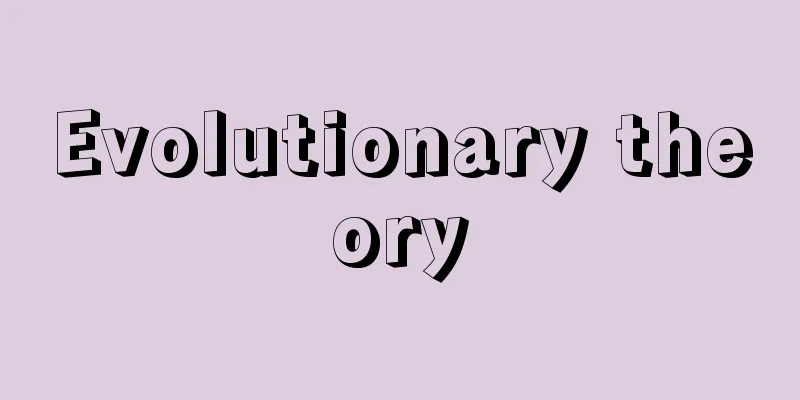Evolutionary theory

|
Living organisms are extremely diverse not only in terms of their morphology, but also in terms of their physiology, behavior, and ecology, and each organism appears to be adapting well to its environment. Attempts to explain this diversity and adaptability as a process that has dynamically changed and developed over a long period of time since life first appeared on Earth are called evolutionary theory in a broad sense. Interest in the origins of living things, including humans, can be seen in many examples, including the so-called creation myths. What are we and where did we come from? The motivation for this question and the satisfaction with the answer generally run through the theory of evolution even today. However, while the theory of evolution has been relatively established as a scientific theory in modern times, eliminating the "mythological explanations" and theological and religious explanations of such origins, it is also true that there are more and more unclear points, that is, points of contention that need to be explicitly explained, and the answers to these questions are open to the future. [Akira Endo] Ancient Greek thought on natureI will start by outlining the ancient Greek explanations for the origin of living things. Anaximander hypothesized metamorphosis, and believed that humans were born from fish-like creatures shedding their skin. Anaximenes imagined that living things arose spontaneously from moist earth. Empedocles preached the bizarre theory that each part of the body first arose, and then they combined to create a complete living thing. The ideas of early Greek natural philosophers about the origin of the world and living things are characterized by the assumption that the act of creation was done without a god, that is, that it occurred naturally without any design. However, after Socrates, for example, Plato's ideas leaned significantly toward metaphysical thinking, where ideas that are the exact opposite of evolutionary thought became dominant. In other words, they assumed a harmonious whole - a universe filled with a soul, and assumed a power called the Demiurge as the creative force of living things (or all things) instead of simple spontaneous generation. Plato has even been described as the anti-hero of evolutionary theory. However, his student Aristotle built a sophisticated classification system based on abundant concrete data about animals, and achieved an outstanding level in both the recognition of animal diversity and the recognition of their functions. It had content that reached the time of Linnaeus in the 18th century. Although he was later assigned the idea of a "stage of nature," Aristotle himself is said to have only explained adaptive phenomena teleologically and not to have conceived an evolutionary idea. In the end, the Greek idea of time was only circular - a cyclical change that constantly returns to the origin - and it must be said that placing the diversity and adaptability of living organisms in the context of historical time was outside the framework of the explanatory logic of the time. However, it is worth noting that the teleological explanation shows an aspect that is in some sense common to the synonymous repetition of the concept of adaptation. [Akira Endo] The Influence of the Christian WorldviewNow, the first major influence on this change in the idea of cyclical time was the Christian worldview. The Bible tells of the beginning and end of the world, and established the idea of linear time. However, regarding the origin of living things, the six-day creation myth and the "ark myth" were popularized, and as a result, they continued to "support" the long prehistory until the appearance of the so-called evolutionary explanation. It was a kind of paradigm in the sense that it excluded other explanations. The creation-stability-catastrophe scheme in the Christian worldview basically does not acknowledge any changes in living things during their life. A. Augustine linked the work of the creator to the growth of a tree, and Thomas Aquinas similarly regarded creation as a progressive process unfolding due to the power given to things by God. In a sense, the idea of "programmed evolution" sprouted from Aristotle's teleology to the Christian worldview. In particular, the framework of Thomas Aquinas's view of living things is thought to be related to how Aristotle's zoology, which was introduced to Europe via Arabia from the 13th century onwards, was actively absorbed and supplemented by Albertus Magnus and others. [Akira Endo] The rise of modern evolutionary thoughtIn the 16th and 17th centuries, many natural history books began to be published. The lineage of natural history itself, from Aristotle onwards, includes Pliny the Elder's Natural History and the allegorical Physiologus, which are believed to have been widely read throughout the Middle Ages, and should not be overlooked. However, from this period onwards, natural history books containing "monsters" continued to be popular. The discovery of unknown creatures was naturally brought about as people's sphere of activity expanded, but the "monster images" that arose in the process of recovering the meaning of words (Latin and ancient Greek) that had lost their substance were probably inevitable "errors." The "discovery" of monsters and deformities was also an expression of the cracks in the Christian world order, or harmony, but it was also a noteworthy (and perhaps more emphatic) undercurrent that concretely reinterpreted the diversity of living things. In the 17th century, Francis Bacon attempted a major revolution in academic frameworks, advocated anti-Aristotelianism, and advocated the necessity of experimental natural history (including the natural history of deformed organisms). Regardless of the actual extent of Bacon's influence, natural history works such as "Atlas of Anatomy," "Flora," and "Zauna" were published one after another from the 16th century onwards, and the diversity of living things was more concretely illustrated than ever before. Philosophically, the influence of Leibniz's theory of pre-established harmony of continuity and plenitude (plenitude) cannot be ignored, as symbolized by the phrase later favored by C. Darwin, "nature does not make leaps." The great trend of natural history culminated in Linnaeus' classification system, which was based on empirical "species." In particular, J. Rey considered the adaptive nature of species to be evidence of God's design, and this is said to have had a great influence on Linnaeus. Moreover, this idea was later articulated in the lines of theological teleology by W. Paley (1743-1805) and others. Animals and plants are more wonderful machines than any machine created by humans, and are the product of God's intelligence that surpasses human intelligence. Linnaeus' classification system also placed the immutability of species at the base. In this era, when the diversity of living things was grasped more concretely, the order of that diversity and its adaptability (perfection) were being reconstructed in the hands of God's creation. Or, on the borderline of this, it was backed by the Leibnizian worldview of pre-established harmony (for example, along the lines of deism). The concept of continuity was expressed by Bonnet as a view of nature as a "great chain of beings" using the term e. volve, or development = evolution. However, the 18th century was an "age of change." The idea that living things change also gradually became so universal that even Linnaeus, who believed in the immutability of species, began to shake his belief in his later years, and it can be said that an inevitable great crack began to appear in the Christian world of harmony, which seemed to have overcome the problem of "monsters" by the system of nature based on the ordering of classification. B. de Meillet (1656-1738) wrote "Tyriamede" in which he expressed the idea that the Earth's surface was originally covered by the sea, and that aquatic plants and animals lived there, and when land eventually appeared, they came ashore and metamorphosed - that all terrestrial organisms were the result of the metamorphosis of ancestors of aquatic origin. Furthermore, Maupertuis wrote "Venus Vitae" and "Systema Naturae" in which, in order to explain the original perfection, he assumed genetic particles with the ability to discern and remember, and emphasized the stability of species. This shows the influence of Leibniz's "Monadology." Moreover, it is said that he saw through the fact that chance influences on genetic particles produce new species, and that selection (selection) plays a role, although it is not sufficient. In addition, Buffon conceived and wrote the magnificent "History of Nature," presenting the causal law of transition from the inorganic to the organic world, as proposed by the French Encyclopedists, who considered the evolution of living organisms along with the history of the Earth. [Akira Endo] From Lamarck to Darwin's Theory of Evolution E. Darwin -- grandfather of C. Darwin -- proposed, albeit in a non-systematic way, in "The Temple of Nature" (1803) and "Zoonomia" (1794-1796), the idea that organisms originated in the sea and evolved onto land by acquiring new characteristics on their own. However, it was Lamarck who developed the idea of evolution all at once. As he constructed a classification system ranging from minerals and plants to animals, Lamarck regarded the overall trend as evolution. The principles presented in "Philosophy of Animals" (1809) were as follows: (2) All living organisms have an inner need to act in order to survive in response to changes in the environment, and fluidity supports this need. (3) Furthermore, the traits acquired through new use are transmitted from generation to generation, resulting in increased complexity (inheritance of acquired traits). This is a well-known story that explains why giraffes have long necks. Here, I will explain the evolution of snail horns (antenna). "The snail, while crawling, feels the need to touch an object in front of it. It makes an effort to touch it with the tip of its head. As it does so, it sends fluid there, causing the tip of its head to elongate. Eventually, nerves extend there, and the antennae become permanently complete. The snail that acquired the antennae then passes them on to its offspring, or inherits them." Lamarck's theory of evolution was an examination of the perfection of simple to complex organisms, and was also a theory of continuous spontaneous generation, which holds that the simpler the organisms currently in existence, the more recent their origins. At roughly the same time, Goethe was interested in the morphology of organisms, and understood metamorphosis as the principle of change from an original form. Cuvier, the founder of vertebrate paleontology, expressed his opposition to Lamarck's theory of evolution from a positivist standpoint. He studied the fossils of many organisms and examined their morphological correlations, but through the analysis of the strata containing fossils, he found that the idea of upheaval and succession of the earth's crust, accompanied by the creation of new fauna and flora at each stage, was justified (catastrophe theory). Geoffrey Saint-Hilaire also attempted to combine the concepts of discontinuity of form and continuity of origin, based on the hypothesis that the higher classification categories of new species originate from the chance appearance of monsters that can thrive. This was a brilliant insight at the time. How can we explain the diversity and adaptability of living organisms without assuming a predetermined blueprint or shining a light on a designer from behind the scenes? C. Darwin and A. R. Wallace were among those who tried to explain things in this direction without teleology. In particular, Darwin, in On the Origin of Species (1859), basically explained the mechanism of evolution using the following logic: (1) Individuals within a species exhibit remarkable and continuous variation in their morphology and physiology, (2) and this variation arises randomly and is heritable. (3) Animal and plant populations have a very high reproductive capacity. (4) However, resources are limited, and individuals in a population must fight for their own survival and the survival of their offspring. (5) Thus, only a few individuals (the fittest) survive and leave offspring with the same characteristics. (6) Through this natural selection of the fittest, a species becomes composed of the best-adapted individuals. The premise of this explanation is only heritable variability and limited resources, and the result, natural selection, is, so to speak, automatically derived. To what extent can the complex and diverse living organisms that exist today be explained by merely selecting random mutations? This question was not ultimately answered clearly at the time, and in some sense it is still not answered today. However, the fact is that the diversity and adaptability of living organisms are not designed in advance, but in principle are the historical product of mutation and selection. Of course, Darwin did not go beyond the "common sense" of genetics at the time, which recognized the inheritance of acquired characteristics (he believed that particles carrying heredity called gemules migrate from somatic cells to reproductive cells and that acquired characteristics are inherited), and although he assumed that the unit of selection was the individual, this was not necessarily the end of it, and he did not fully understand the mechanism of speciation (differentiation). Furthermore, the geological time and fossil records were not in a position to be trusted. Despite such errors and limitations, the principle of natural selection was developed by Darwin for the world of living organisms, even if he was influenced by Malthus and H. Spencer. The basic framework for explaining biological evolution is still based on Darwin's idea of natural selection. [Akira Endo] New developments in geneticsIn the second half of the 19th century, various theories of evolution were proposed. The importance of geographical isolation in speciation was emphasized from different perspectives by MF Wagner (1813-1887) and JT Gulick (1832-1923). Wagner pointed out the effect of different environments, while Gulick pointed out that divergence can occur even without environmental differences. Nägeli emphasized that internal directional forces guide the direction of evolution completely independently of the environment, while Eimer emphasized that evolution is not necessarily adaptive but proceeds in a directed manner. Cope revived the Lamarckian view based on paleontological considerations (neo-Lamarckism). In the field of genetics, Weissmann later derived from the germ line theory (the idea that it is germ plasm that is transmitted from generation to generation, and somatic plasm is a dead end) that the inheritance of acquired characteristics is impossible. This is now basically supported by molecular genetics. Regarding the transmission of genetic characteristics, Mendel's statistical empirical results were rediscovered by de Vries et al. in 1900, which led to the discovery of mutations, and further, through the development of Drosophila genetics by T. H. Morgan and his group, genes came to be understood as having loci on chromosomes. [Akira Endo] Synthesis of evolutionThe possibility of speciation through mutation was also examined through theoretical research into changes in the frequency of alleles at many gene loci in populations (populations) that act as gene pools (microevolution). In other words, R. A. Fisher, S. Wright (1889-1988), J. B. S. Haldane and others established population genetics, and the importance of understanding evolution as a phenomenon of populations came to be recognized. These studies paved the way for the "synthetic theory" of evolution, which we will look at next. From the 1930s to the 1950s, attempts were made to unify evolution into a synthesis. J.S. Huxley, G.G. Simpson in paleontology, E.W. Mayr (1904-2005) in phylogenetics, and Dobzhansky in genetics all expressed a synthesis of evolutionary theory in their respective works. The synthesis is based on the chromosome theory of inheritance, population genetics, and the concept of biological species, and it reorganizes and expands the concepts of paleontology and various biological fields. Its main points are the complete denial of acquired trait inheritance, that the evolutionary process is a gradual change, that mutations can be explained based on the change in gene frequency within a population (Mendelian population) = microevolution, and that the direction of evolution is determined by natural selection. It was reconstructed as the so-called neo-Darwinian theory of evolution. Through these attempts, it came to be thought that all problems in biology require an evolutionary explanation. In particular, it has had a major impact on molecular genetics, ethology, ecology, and other fields. The significance of the existence of various biological structures and functions has been questioned, and it has become common to explain their selective benefits. It could even be said that new research into evolution has now begun. However, progress in research varied from field to field, and until the 1950s, it seemed difficult to explain the evolution of animal social behavior or sexual reproduction by natural selection. Furthermore, as seen in the so-called Lysenko controversy, criticism of the particle theory of heredity remained strong. Meanwhile, biochemical research subsequently provided support for the "one gene/one enzyme" theory, and in 1953 J. D. Watson and Crick grasped genes as deoxyribonucleic acid (DNA), and by the 1960s the concept of genes and the basic elucidation of the genetic mechanism at the molecular level had progressed. The central dogma that genetic information flows from nucleic acids to proteins was interpreted as an explanation of Weissmann's principle at the molecular level, and it had a decisive impact on the debate over the inheritance of acquired characteristics. Modern evolutionary theory cannot be discussed without taking into account the development and achievements of molecular genetics. [Akira Endo] Perspectives on evolutionary researchThe current state of evolutionary theory has been remarkable since the 1960s until the present day. Intense research has taken place in various fields of biology and paleontology, and numerous controversies and achievements have been generated, rewriting entire textbooks in each field. It is necessary to only list the main points here. (1) Is the pattern of macroevolutionary change gradual or is it composed of abrupt changes and long periods of stagnation? (2) Is the unit of natural selection an individual, a population, or a gene? (3) Is evolution explained by an adaptation program or a neutral theory? (4) Regarding taxonomic methods, should we use phenotypic, cladistic, or evolutionary taxonomy? (5) Regarding speciation, should we use allopatric, sympatric, or parapatric? None of these are simply a matter of which to adopt, nor is it a matter of simply compromising. Many important debates have been unfolding regarding fundamental viewpoints on evolution. Of course, many new facts and hypotheses have been born behind these developments. With regard to the origin of life, bold verification experiments of its biochemical basis and theoretical understanding of the formation of nucleic acid-protein systems have progressed. In addition, the existence of neutral mutations at the molecular level has been revealed, the immune system has been elucidated, and gene analysis technology has made great advances. The complexity of the genetic mechanism of eukaryotes is gradually becoming clear, and it is no longer possible to simply fit it into the framework of the traditional central dogma based on prokaryotes. With regard to the origin of eukaryotes, the symbiosis theory of prokaryotes is becoming quite plausible due to the homology between their intracellular organelles and some prokaryotic cells. If this is true, the theory of speciation, which has been considered to be a branching process, will have to be fundamentally revised to this extent. Regarding the evolution of chromosomes, the gene duplication theory has been proposed, and its validity is being recognized in some plants. The mechanism of development and differentiation remains a difficult problem, but some interesting hypotheses have been put forward. The origin of sexual reproduction is one of the important problems to be solved in the future, but its evolutionary significance is becoming deeply recognized. New perspectives have also been developed on animal behavior, and not only have we uncovered neurophysiological mechanisms, but we have also gained a great deal of new knowledge about mating behavior, mimicry, altruistic behavior, and so on. In ecology, progress has been made in elucidating life histories and social structures, including the rK selection theory of natural selection, and attempts have been made to study biological communities based on the concept of competition. Furthermore, interest in and understanding of coevolution and the interactions between living organisms is deepening. Furthermore, not only has paleontology been reconstructed based on the theory of continental drift, but stimulating debates have also been taking place over the cause of the so-called mass extinctions, triggered by the meteorite theory. Based on various facts and new perspectives, it appears that the traditional synthesis is once again being reconstructed in a broader form as evolutionary biology, but many objections have also been raised to the old neo-Darwinian framework, many of which are simply misunderstandings, and it is likely that developments will continue to be turbulent in the future. [Akira Endo] "Nature Selection: Modern History of Evolutionary Thought" by Yasugi Ryuichi (1972, Chuokoron-Shinsha)" ▽ "The History of Biology, Volumes 1 and 2, by Yasugi Ryuichi (1984, NHK Publishing)" ▽ "Darwin Resurrected: The Story of Evolution" by Ogawa Mariko (2003, Iwanami Shoten)" ▽ "Illustrated Trivia: Evolution, 2nd Edition, by Nakahara Hideomi (2005, Natsume-sha)" ▽ "On the Origin of Species, Volumes 1 and 2, by C. Darwin, translated by Yasugi Ryuichi (Iwanami Bunko)" ▽ "Animal Philosophy, by J.B. Lamarck, translated by Koizumi Tan et al. (Iwanami Bunko)" ▽ "The Challenge of Evolution" by Sakura Osamu (Kadokawa Sophia Bunko)" ▽ "The History of Biology, New Edition, by Nakamura Yoshiri (Chikuma Gakugei Bunko)" [References] | | | | | |Source: Shogakukan Encyclopedia Nipponica About Encyclopedia Nipponica Information | Legend |
|
生物はその形態のみならず、生理、行動、生態にわたり著しく多様であり、しかもそれぞれの生物はその生活環境にうまく適応して生きているかにみえる。この多様性と適応性を、地球上で生物が誕生して以来、長い時間経過のなかで動的に変化・展開してきた過程として説明する試みを、広い意味で進化論あるいは進化理論という。 ヒトを含めた生物の由来への関心は、いわゆる創世神話をはじめ多くの例にみることができる。われわれが何であり、どこからきたのか。この問いかけの動機とその答えへの納得が一般にはいまも進化論を背後から貫いている。しかし、そうした由来についての「神話的説明」や神学的、宗教的説明を排除し、近代になって進化論が科学理論としてそれなりに確立してきているが、不明な点、つまり明示的に説明されるべき論点がいっそう増えてきたことも確かであり、それらの問いへの答えは未来に向けて開かれている。 [遠藤 彰] 古代ギリシアの自然思想生物の由来についての古代ギリシアの説明をまずは概説する。アナクシマンドロスは、変態を仮想し、魚のような生物が脱皮して人が生まれたと考えた。アナクシメネスは、生物は湿った大地から自然発生したと想像した。エンペドクレスになると、身体のそれぞれの部分がまず発生し、それらがうまく結合して完全な生物が誕生した、という奇怪な説を唱えた。初期のギリシアの自然哲学者たちの世界・生物の起源についての思想は、端的にいうと、創生の作用は神なしに行われたこと、つまりなんのデザインもなしの自然発生を想定したという特徴をもつ。ところが、ソクラテス以降になると、たとえば、プラトンのように著しく形而上(けいじじょう)学的思考に傾斜し、そこではむしろ進化的思想と正反対の観念が支配的になる。すなわち、調和的全体――霊魂に満たされた宇宙が想定され、生物(もしくは万物)の創造力として素朴な自然発生にかえてデーミウルゴスという力能が仮定されるからである。プラトンは進化論のアンチヒーローとさえ評されることになる。しかし、その弟子であったアリストテレスは、動物についての豊富な具体的資料に基づき、高度の分類体系を築き、動物の多様性の認識においても、その機能の認識においても、卓越した水準を達成した。それは遠く18世紀のリンネの時代に届くほどの内容を備えていた。のちに「自然の階梯(かいてい)」の観念をあてがわれはしたが、アリストテレス自身は適応的現象を目的論的に説明するに終始し、進化的観念を懐胎していないとされる。結局、ギリシア時代の時間観念は円環的――絶えず始源に回帰する周期的変化――でしかなく、生物の多様性や適応性を歴史的時間の脈絡に置くこと自体が、当時の説明論理の枠外にあったといわねばならない。ただ、目的論的説明は、適応概念の同義反復性とある意味で通底する側面を示している点は注目してもよいと思われる。 [遠藤 彰] キリスト教的世界観の影響さて、この円環的時間観念の変革に最初に大きな影響を与えたのはキリスト教的世界観であった。聖書は世界の始源と終末を語り、直線的時間観念を定着させた。しかし、生物の由来については、6日間の創造の神話と「箱舟神話」を流布し、結果的には、いわゆる進化的説明が登場するまでの長い前史を「支え」続けた。それ以外の説明を排除してきたという意味で一種のパラダイムであったろう。キリスト教世界観における生成――安定――破局の図式は、生物の途中の変化を基本的には認めない。A・アウグスティヌスは、創造者の仕事を1本の樹木の成長に結び付けたし、トマス・アクィナスも、同様に創造を神によって事物に与えられた力により前進的に展開された過程とみなした。ある意味では「プログラムされた進化」という発想が、アリストテレスの目的論からキリスト教的世界観へ至って芽生えてきたともいえよう。とりわけ、トマス・アクィナス的生物観の枠組みは、13世紀以降アラビア経由でヨーロッパに紹介されたアリストテレスの動物学が、アルベルトゥス・マグヌスなどに積極的に摂取され補強された経緯と関連しているとみられる。 [遠藤 彰] 近代進化思想の台頭16~17世紀になると、多くの博物誌が刊行され始める。博物誌そのものの系譜は、アリストテレス以降は、ローマの大プリニウスの『博物誌』や、寓意(ぐうい)に満ちた『フィシオロゴス』が中世を通じてかなり広く読まれたとみられており、見逃せないが、この時代以降には「怪物」を含む博物誌が延々と流行した。未知の生物の発見は人々の活動範囲の拡大とともに当然もたらされるものであるが、実体を失ったことば(ラテン語や古代ギリシア語)の意味を再生する途上の「イメージの怪物」もおそらく不可避の「錯誤」であったろうし、怪物や奇形の「発見」は、キリスト教的世界秩序=調和の亀裂(きれつ)の表明でもあったとみえるが、生物の多様性が具体的にとらえ直される注目すべき(もっと強調されてよい)底流であったと思われる。17世紀には、F・ベーコンは、学問的枠組みの大革新を企図し、反アリストテレス主義を標榜(ひょうぼう)し、実験的博物誌(奇形の博物誌も含めて)の必要性を説いた。ベーコンの影響が実質的にどれほどであったかはともかく、16世紀以降は博物誌の著作『解剖図譜』『植物誌』『動物誌』が次々と出版され、生物の多様性は以前にもまして具体的に図像化されてとらえられるようになった。哲学的には、ライプニッツの連続性と充満(プレニテュード)の予定調和説が、「自然は飛躍しない」という、のちにC・ダーウィンの好んで用いたフレーズに象徴される形で与えた影響も無視できない。 博物誌(学)の大潮流は、経験的な「種」を、リンネの分類体系に結実させることとなった。とりわけ、J・レイは、種の適応的性質を神のデザインの証拠とみなしたし、それはリンネに大きな影響を与えたとされている。しかも、その発想はのちにペイリーW. Paley(1743―1805)などによってさらに神学的目的論の線で明確に述べられた。動物や植物は、人間のつくった機械よりすばらしい機械であり、これは人間の知性を超えた神の知性の産物である、というわけである。 リンネの分類体系においても、種の不変性は基本に置かれていた。生物の多様性をより具体的に把握してきたこの時代は、その多様性のもつ秩序とその適応性(完全性)をともに神の創造の手の内に再構成しようとしていた。あるいはそれとすれすれのところでライプニッツ流の予定調和の世界観に裏打ちされていた(たとえば理神論の線で)。連続性の概念は、e. volveつまり展開=進化ということばでボネによって「存在の大連鎖」の自然観として表明された。しかし、18世紀は「変化の時代」であった。生物も変化するという観念は、種の不変性を信じていたリンネですら、晩年にはその信念を揺るがせることになったほどに、徐々に普遍的になり、分類の整序による自然の体系によって「怪物」問題を乗り越えたかにみえたキリスト教的調和世界に、避けられない大亀裂が走り始めたといえよう。ド・メイエB. de Meillet(1656―1738)は『ティリアメッド』を書き、地球表面は最初海で覆われ、水生の植物・動物がいて、やがて陸が現れると、それらは上陸し変態した――すべての陸上生物はそれぞれ水生起源の祖先が変態してきた、という考えを表明した。さらにモーペルチュイは『生身のヴィーナス』『自然の体系』を書いて、原初の完全性を説明するために、識別力や記憶力をもつ遺伝粒子を想定し、種の安定性を強調した。これにはライプニッツの『単子論(モナド論)』の影響がみられる。しかも、その遺伝粒子への偶然的影響が新種を生み出すこと、十分とはいえないが選択(淘汰(とうた))の役割も見抜いていたといわれる。また、ビュフォンは壮大な『自然誌』を構想、執筆し、地球の歴史とともに生物の変化=進化を視野に入れたフランス百科全書派の、無機界から有機界への因果的合法則性を提示してみせた。 [遠藤 彰] ラマルクからダーウィンの進化論へE・ダーウィン――C・ダーウィンの祖父――は『自然の殿堂』(1803)や『ズーノミア』(1794~1796)のなかで、体系的ではないが、生物が自ら新しい特徴を得ることによって海で生まれ、陸上へ進化したとの考えを唱えた。しかし、進化の考えを一挙に展開したのはラマルクであった。ラマルクは鉱物、植物から動物に至るまでの分類体系を構築しながら、その全体的傾向を進化ととらえた。『動物の哲学』(1809)で示された原理は、 (2)すべての生物は環境の変化から生じる生存のための行動を担う内的な必要性をもち、それを支えるのが流動体である。 (3)また、新たに使用することによって獲得される形質を世代から世代へと伝播(でんぱ)し、これが複雑化を実現した(獲得形質の遺伝)。 このような原理で、キリンの首がなぜ長いのかを説明したエピソードはよく知られている。ここではカタツムリの角(つの)(触角)の進化を説明してみる。「カタツムリははいながらその前方の物体に触れる必要を感じた。そしてその頭の先端でそれに触れようと努力する。そうするうちにカタツムリは流動体をそこへ送り、頭の先端を伸長させた。そしてついにはそこへ神経が伸び触角は永久に完成した。さらに触角を獲得したカタツムリは親から子へとそれを伝達つまり遺伝した」。このラマルクの進化論は、単純から複雑への完全化の検討であり、現存する単純な生物ほどその由来が新しいとみる、連続自然発生説でもあった。ほぼ同時代、ゲーテは生物の形態に関心を寄せ、変態(メタモルフォーゼ)を原型からの変化の原理として把握していた。 脊椎(せきつい)動物の古生物学の創始者でもあるキュビエは、実証主義的立場から、ラマルクの進化論への反対を表明した。彼は多数の生物の化石を研究し、その形態上の相関関係を検討したが、化石を含む地層の分析を通して、各段階で新たな動物相や植物相の創造を伴った地殻の激変と遷移の考え方が正当化されるとみた(天変地異説)。また、ジョフロア・サンチレールは、新しい種の上位の分類カテゴリーが、繁栄することのできる怪物の偶然的出現によって出発するとの仮説から、形態の不連続性と由来の連続性の概念を結合しようと試みた。これは当時としてはすばらしい卓見というべきであろう。 生物の多様性と適応性を、あらかじめ決められた設計図を想定したり、設計者の背後から光を当てて説明することなしに、どのように説明できるであろうか。この方向で、目的論を排して説明してみせたのがC・ダーウィンやA・R・ウォーレスであった。とくにダーウィンは『種の起原』(1859)において、進化の機構を基本的に以下の論理で説明した。 (1)種内の個体はその形態と生理に著しい連続的変異があり、(2)この変異は機会的に生じ、遺伝する。(3)動物や植物の個体群は非常に高い増殖能力をもつ。(4)しかし資源は限られており、ある個体群の個体は自らの生存とその子孫の生存を目ざして闘争しなければならない。(5)したがって、いくつかの個体(最適者)だけが生き残り、同じ性質をもった子孫を残す。(6)この最適者の自然選択(淘汰)を通して、種はよりよく適応した個体によって構成されるようになる。 この説明の前提は、遺伝する変異性と限られた資源だけであり、その帰結=自然選択はいわば自動的に導かれる。機会的変異を選択するだけで、現存している複雑に統合されている多種多様な生物をどこまで説明できるのか。この疑問には、当時も、そしてある意味では現在でも、究極的には明解に答えられてはいない。しかし、事実として、生物の多様性と適応性があらかじめ設計されたものではなく、原理的には変異と選択の歴史的産物であるという理解の枠組みは確立された。もちろん、ダーウィンは、遺伝機構については獲得形質の遺伝を認める当時の遺伝学の「常識」を超えてはいなかったし(ジェミュールという遺伝を担う粒子が体細胞から生殖細胞へ移動して獲得形質が遺伝すると考えていた)、選択の単位については個体を想定していたものの、かならずしもそれで尽きるものではなかったし、種形成(分化)の機構の理解も十分ではなかった。それに地質年代や化石記録にも信頼を置ける状況ではなかった。そうした誤りや限界がありながらも、自然選択の原理は、マルサスやH・スペンサーの影響を受けたにせよ、ダーウィンによって生物の世界について展開された。生物進化を説明する基本的枠組みは現在もこのダーウィンの自然選択の考え方を基礎としている。 [遠藤 彰] 遺伝学の新たな展開その後、19世紀後半には、さまざまな進化理論が提唱された。種分化における地理的隔離の重要性はワグナーM. F. Wagner(1813―1887)とグリックJ. T. Gulick(1832―1923)により異なった視点から強調された。ワグナーは異なった環境の作用を、グリックは環境の差異がなくても生じる分岐のあることを指摘した。また、ネーゲリは内的指向力が環境とはまったく独立に進化の方向を導くことを、アイマーは進化がかならずしも適応的ではないが定向性をもって進むことを強調した。コープは古生物学的考察に依拠したラマルク的見解を復活させた(ネオラマルク主義)。 遺伝学については、その後、ワイスマンが生殖系列説(世代を越えて伝わるのは生殖質であり、体細胞質は行き止まりであるという考え)から獲得形質の遺伝が不可能なことを導いた。これは現在、分子遺伝学によって基本的に支持されている。遺伝的形質の伝わり方については、メンデルの得た統計的経験的結果が1900年にド・フリースらによって再発見され、また突然変異が発見されるに至り、さらに、T・H・モーガン一派のショウジョウバエ遺伝学の発展を経て、遺伝子は染色体上に座位をもつものとして理解されるようになった。 [遠藤 彰] 進化の総合説また、突然変異による種分化の可能性は、遺伝子プールとしての個体群(集団)における多くの遺伝子座にある対立遺伝子の頻度の変化(小進化)の理論的研究によって検討された。すなわち、R・A・フィッシャー、ライトS. Wright(1889―1988)、J・B・S・ホールデンらが集団遺伝学を確立し、進化を集団=個体群の現象として理解することの重要性が認識されるようになった。これらの研究が次にみる進化の「総合説」を準備することになる。 1930~1950年代にかけては、進化の総合説への統一化が試みられた。J・S・ハクスリーをはじめ、古生物学のG・G・シンプソン、系統進化学のマイアE. W. Mayr(1904―2005)、遺伝学のドブジャンスキーらは、それぞれの著作のなかで進化理論の総合化を表明した。総合説は、遺伝の染色体理論、集団遺伝学、生物学的種の概念を軸とし、古生物学や生物学諸分野の概念を整理拡張し、獲得形質遺伝の完全な否定、進化過程が漸進的な変化であり、突然変異は集団(メンデル集団)内の遺伝子頻度の変化=小進化を基本として説明でき、その進化の方向は自然選択によって規定される、という内容を骨子としている。いわゆるネオダーウィン主義の進化理論として再構成されたわけである。そうした試みを経て、生物学のあらゆる問題は進化的な説明を必要としていると考えられるようになった。とりわけ、分子遺伝学、行動学、生態学などに大きな影響を与えてきた。さまざまな生物学的構造や機能の存在する意義が問われ、その選択的利益を説明することが一般化してきた。進化についての新たな研究がむしろここから再出発したともいえよう。 しかしながら、研究の進展は分野によってさまざまであり、1950年代までは、たとえば動物の社会行動や有性生殖の進化を自然選択で説明することは困難にみえていた。さらに、いわゆるルイセンコ論争にみられるように、遺伝=粒子論批判も根強いものがあった。 一方、遺伝子は、その後、生化学的な研究によって「一遺伝子/一酵素」説の裏づけを得て、1953年J・D・ワトソンとクリックによりDNA(デオキシリボ核酸)として実体的に把握されるに及び、1960年代までに遺伝子概念、遺伝機構の分子レベルでの基本的解明が進んだ。遺伝情報が核酸からタンパク質へ流れるというセントラルドグマは、ワイスマンの原理を分子レベルで説明したものと解され、獲得形質遺伝をめぐる論争に決定的ともいえる衝撃を与えることとなった。現代の進化論は、この分子遺伝学の発展・成果を抜きにしては語れない。 [遠藤 彰] 進化研究の展望1960年代から現在に至るまで、進化理論をめぐる現代の状況には目覚ましいものがある。生物学の各分野や古生物学の活発な研究が相次ぎ、数多くの論争そして成果が生み出され、各分野の教科書は軒並みに書き変えられてしまった。ここでは主要な論点を列挙するにとどめざるをえない。 (1)大進化の変化パターンは漸進的かそれとも急激な変化と長い停滞からなるか、(2)自然選択の単位は個体か集団かそれとも遺伝子か、(3)進化を説明するのは適応論プログラムか中立説か、(4)分類学の方法をめぐって、表形分類か分岐分類かそれとも進化分類か、(5)種形成論をめぐって、異所的か同所的か側所的か、など、いずれも単純にどちらを採用するかということではなく、といって単純に折衷すればよいというのでもない。進化についての根本的視点にかかわって重要な論争が数多く展開されてきている。 それらの背景には、もちろん新しい事実や仮説が数多く生まれてきている。生命の起源についても、その生化学的基盤の大胆な検証実験や核酸―タンパク質系の生成に関する理論的理解が進展した。また、分子レベルの中立突然変異の存在が明らかにされ、免疫機構の解明が進み、また遺伝子の分析技術も飛躍的に進歩し、真核生物の遺伝機構の複雑さがしだいに明らかになりつつあり、従来の原核生物を基盤にしたセントラルドグマの枠組みには単純には収まらなくなってきた。その真核生物の起源に関しても、その細胞内小器官といくつかの原核細胞との相同性から、原核生物の共生説がかなり有力視されてきている。これが事実だとすると、分岐一方で考えてきた種形成論も、この限りにおいては根本的に修正を迫られることになる。染色体の進化についても遺伝子重複説が提出され、植物の一部では妥当性を認められつつある。発生分化の機構は依然として難題だが、いくつかの興味深い仮説も出されている。有性生殖の起源は将来解かれるべき重要問題の一つであるが、その進化的意義は深く認識されるようになってきた。また、動物の行動についても新しい見方が生まれ、神経生理機構の解明にとどまらず、配偶行動や擬態、利他的行動などについての数多くの新しい知見が得られてきた。生態学でも、自然選択に関してr-K選択説をはじめ、生活史や社会構造についての解明が進み、競争概念を基礎にした生物群集論も試みられ、さらに共進化や生物の相互作用の理解、関心が深まりつつある。さらに、大陸移動説を踏まえた古生物学の再構成はもちろんのこと、いわゆる大量絶滅の原因についても隕石(いんせき)説を発端に刺激的な論争も行われている。 さまざまな事実や新しい視点によって、従来の総合説は進化生物学として、より広範な形でいま一度再構築されつつあるかにもみえるが、旧来のネオダーウィン主義の枠組みへの多くの異論も出され、そのなかには単なる誤解も多々あるものの、今後も波瀾(はらん)含みで展開するものと思われる。 [遠藤 彰] 『八杉竜一著『自然選書 近代進化思想史』(1972・中央公論社)』▽『八杉竜一著『生物学の歴史』上下(1984・日本放送出版協会)』▽『小川眞里子著『甦るダーウィン――進化論という物語り』(2003・岩波書店)』▽『中原英臣著『図解雑学 進化論』第2版(2005・ナツメ社)』▽『C・ダーウィン著、八杉竜一訳『種の起原』上下(岩波文庫)』▽『J・B・ラマルク著、小泉丹他訳『動物哲学』(岩波文庫)』▽『佐倉統著『進化論の挑戦』(角川ソフィア文庫)』▽『中村禎里著『生物学の歴史』新版(ちくま学芸文庫)』 [参照項目] | | | | | |出典 小学館 日本大百科全書(ニッポニカ)日本大百科全書(ニッポニカ)について 情報 | 凡例 |
<<: Shinkawa [town] - Shinkawa
Recommend
Smell (smell) - Smell (English spelling)
A sensation caused by the sense of smell. Usually,...
Kagawa lacquerware
Lacquerware produced mainly in Takamatsu City, Kag...
Vascons
...For example, the Gascon dialect is extremely u...
Yuri Kimimasa
A politician from the end of the Edo period and t...
Biological effect of radiations
The biological effects of radiation begin with the...
Claw hook - Tsumakake
An accessory for footwear. It is used to protect ...
Otogi Bunko - Fairy Tale Library
In the narrow sense, it refers to the 23 illustra...
Extremely silly and clever
1363-1452 A monk from the Muromachi period. Born ...
Consolidated financial statements
Financial statements prepared by treating a corpo...
Bedding stratification
The layered arrangement of rocks found in sedimen...
Lilium regale (English spelling) Lilium regale
…[Tetsuichi Yahara]. … *Some of the terminology e...
Naishi -
The Naishi no Tsukasa, an official in the Imperia...
Science of Education
In contrast to speculative pedagogy, which determi...
Incirrata
...In addition to this, experiments have been con...
Parasitic fly - Parasitic fly
…General term for small to medium-sized insects b...









